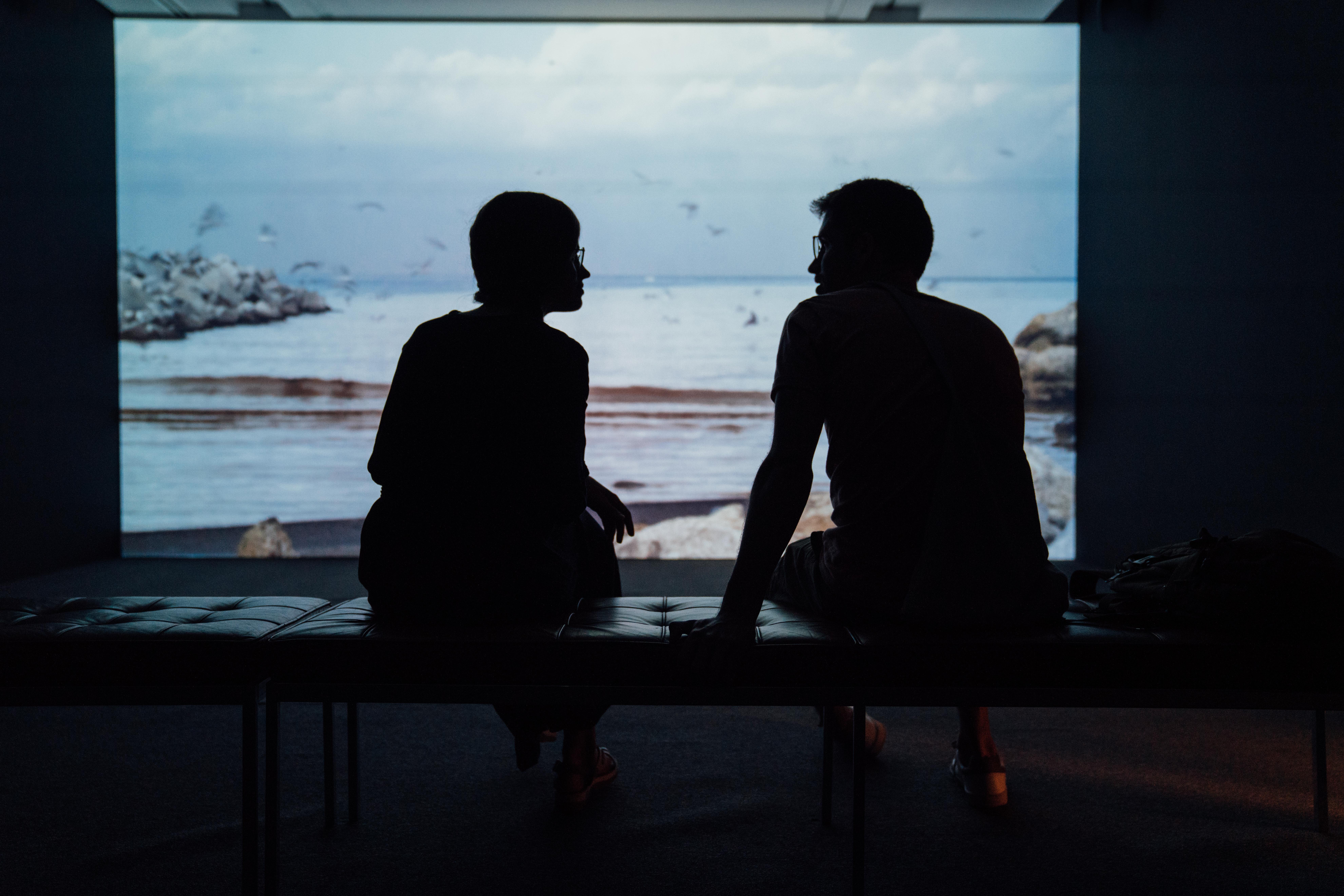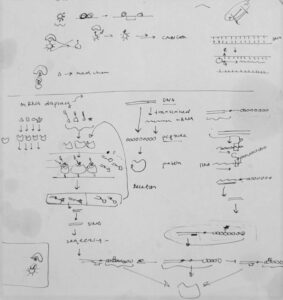
Act I: A Dreadful Feeling
It first happened to me over Thanksgiving dinner a few years back. I was sticking peas to a bite of gravy-dipped mashed potatoes when my aunt casually asked, “So, how are you liking your job in that chemistry lab? What exactly are you doing there?”
In that moment, a simple question asked out of genuine interest in my life made me feel something unexpected: dread.
Deep down, I knew why. The question tasked me with explaining my role in a medicinal organic chemistry lab to my aunt, who worked as a tax accountant. I thought that, to give her a meaningful answer, I would have to explain fundamental concepts such as how chemical bonds form between atoms and how chemists manipulate these bonds to make new molecules. But I knew she wasn’t interested in hearing a lecture on chemistry basics over dry turkey breast and sinfully flavorful gravy.
So, I punted my answer. “It’s going well. I mostly just run a bunch of experiments mixing chemicals together to try and make new chemicals”, I said.
She nodded, said she was glad I was enjoying my job, and switched topics. I thought I did both her and myself a favor by evading what was sure to be an unproductive conversation.
Unbeknownst to me, I would be presented with questions like hers countless times in the years to come. Most of the time, I thought people were just asking to be polite, and they didn’t really want to know. Or even if they did, I didn’t always have the energy to answer well. So, I continued punting and deflecting, unknowingly furthering the distance between science and non-scientists each time.
Act II: Communication is Connection
A turning point came when my twin brother asked me to explain my research to him one night when we were both home for the holidays. Maybe it was the person asking, the quiet of the night, or the comfort that we had nowhere else to be—but, for the first time, I really gave it a shot. I whipped out a notepad and drew figures as I talked. He asked questions; I drew more.

We killed two hours hunched over that notepad, but at the end, he understood. And unexpectedly, I also felt understood. I was struck by the fulfillment I had in getting someone I loved to understand what I do.
After that night, I made a genuine effort to explain my research when I was asked by friends and family. By doing so, I picked up on science communication tools I never knew existed. I learned it was more effective to start with the overall impact of my work, then go into the background as necessary. I assessed the knowledge of who I was talking with and incorporated analogies that would relate to them. I learned the importance of communicating through their vocabulary, not mine.
With time, the type of fulfillment I got from these conversations evolved. Not only was I strengthening connections between myself and my loved ones, but I was also breaking down walls that enclosed the scientific community; I was making traditionally cryptic scientific concepts approachable.
This feat felt important. Even on an individual level, I could sense its potential impact. I felt compelled to talk about science with more people.
I started to write blog posts for my university’s science communication blog, The Pipettepen. I wrote about new research papers, diversity and inclusion in the sciences, and the science behind any topic that struck my fancy. I would share my posts with friends and family, sparking new conversations about science that didn’t revolve around my research. And that same feeling of fulfillment persisted.
Act III: Science Gets the Spotlight
Then, something rare and horrifying happened that would change the way the world thought about science: a viral pandemic.
Suddenly, everyone was desperately searching for information about how diseases spread, how the immune system works, and how drugs are made. Graduate students in the biomedical sciences (myself included) got emails from the government asking for volunteers who could run COVID PCR tests on patient samples. People urgently depended on scientists to relay reliable information, to develop vaccines, to treat the ill.
And in some instances, we failed. When the president suggested injecting disinfectant to fend off the virus, we failed. When two highly respected medical journals retracted articles about the effectiveness of treating COVID-19 with an anti-malarial drug due to data transparency issues, we failed. When the CDC repeatedly changed its recommendations for mask usage, we failed.
There was, of course, a tremendous pressure put on scientists to assume authoritative roles in a scary situation that was new to all of us. But ultimately, the public lost trust in scientists, turning to other public figures and the internet for information. Due to the inaccessibility of scientific papers, both through paywalls and technical jargon, this information likely came from non peer-reviewed sources like social media, worsening the quick spread of misinformation.
Watching all this play out as an early scientist in the pharmaceutical field made me realize how crucial science transparency is and the extent to which it affects society. For me, it transformed science communication from a fun hobby with altruistic intentions to a glaring necessity; from a luxury to a responsibility.
Act IV: We are Not the Gatekeepers of Knowledge
Have you ever tried reading a scientific paper before? How did it go? My guess is that, unless you were already experienced in reading these types of articles or had background knowledge that you yourself acquired through years of formal education, it probably seemed like a foreign language.
Even with a relatively short amount of time in my field, I’ve gotten the impression that a lot of scientists seem perfectly happy talking science exclusively with their colleagues. Because of this, reports of scientific research are usually only written in highly technical language, making it almost impossible for a non-expert to decipher.
This inaccessibility is not only a shame, but a disservice to curious minds everywhere that want to learn about the science going on in the world. All scientists, I think, should care about making it easy for people to understand the impact of their work. Sitting high in an ivory tower does no good if the ground it’s built upon is burning.
Starting my scientific career during such a transformative time (politically, socially, environmentally) has made it undeniable to me that science does not operate in a closed system. It isn’t confined within the walls of high-tech labs or academic conferences. Through science, we gain knowledge, and who are we to limit who learns of it? We should be equally committed to sharing scientific knowledge as we are to obtaining it.
Act V: Breaking Down Barriers
Each of us can make small but tangible changes to improve science transparency to the public. To start, I urge scientists to begin having conversations with friends and family about their work (or anyone’s work for that matter). It may also be helpful to keep a running list of science communicators you like or scientific content that you think is well done, and recommend these sources as educational tools. Books, videos, podcasts–the more varied the content, the better.
On the same token, I implore non-scientists to ditch the pre-existing notions they might have about how science is full of impossibly dense material, and approach scientific topics with an open mind. That being said, be critical of where your science-related content is coming from, especially on social media. For better or worse, the internet gives every person a digital megaphone, making it easy to amplify misinformation.

Many factors contribute to the barrier between the scientific community and the public, but two important ones are jargon and paywalls. It will take time and coordinated efforts to dismantle these, but we are making progress. For example, starting in 2023 the National Institutes of Health (NIH), which funds a lot of academic scientific research, will require all grant applications to include a data sharing plan with the intent of making data publicly available. Additionally, the scientific community is beginning to recognize how science itself can stand to benefit from public involvement, as they are ultimately the funders, advocates, and patients needed for science to progress.
In light of recent global events, public interest in scientific research is at a peak. We can hole up in our ivory towers, or we can step outside and start to put out fires. For the sake of our society, our species, and our planet, I hope we do the latter.
Peer Editors: Nicole Gadda and Aditi Kothari